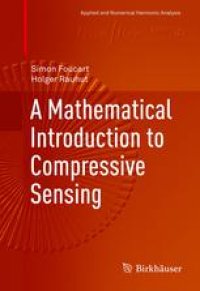
Ebook: A Mathematical Introduction to Compressive Sensing
- Genre: Mathematics // Wavelets and signal processing
- Tags: Computational Science and Engineering, Signal Image and Speech Processing, Math Applications in Computer Science, Communications Engineering Networks, Functional Analysis
- Series: Applied and Numerical Harmonic Analysis
- Year: 2013
- Publisher: Birkhäuser Basel
- Edition: 1
- Language: English
- pdf
At the intersection of mathematics, engineering, and computer science sits the thriving field of compressive sensing. Based on the premise that data acquisition and compression can be performed simultaneously, compressive sensing finds applications in imaging, signal processing, and many other domains. In the areas of applied mathematics, electrical engineering, and theoretical computer science, an explosion of research activity has already followed the theoretical results that highlighted the efficiency of the basic principles. The elegant ideas behind these principles are also of independent interest to pure mathematicians.
A Mathematical Introduction to Compressive Sensing gives a detailed account of the core theory upon which the field is build. With only moderate prerequisites, it is an excellent textbook for graduate courses in mathematics, engineering, and computer science. It also serves as a reliable resource for practitioners and researchers in these disciplines who want to acquire a careful understanding of the subject. A Mathematical Introduction to Compressive Sensing uses a mathematical perspective to present the core of the theory underlying compressive sensing.
At the intersection of mathematics, engineering, and computer science sits the thriving field of compressive sensing. Based on the premise that data acquisition and compression can be performed simultaneously, compressive sensing finds applications in imaging, signal processing, and many other domains. In the areas of applied mathematics, electrical engineering, and theoretical computer science, an explosion of research activity has already followed the theoretical results that highlighted the efficiency of the basic principles. The elegant ideas behind these principles are also of independent interest to pure mathematicians.
A Mathematical Introduction to Compressive Sensing gives a detailed account of the core theory upon which the field is build. Key features include:
· The first textbook completely devoted to the topic of compressive sensing
· Comprehensive treatment of the subject, including background material from probability theory,detailed proofs of the main theorems, and an outline of possible applications
· Numerous exercises designed to help students understand the material
· An extensive bibliography with over 500 references that guide researchers through the literature
With only moderate prerequisites, A Mathematical Introduction to Compressive Sensing is an excellent textbook for graduate courses in mathematics, engineering, and computer science. It also serves as a reliable resource for practitioners and researchers in these disciplines who want to acquire a careful understanding of the subject.
At the intersection of mathematics, engineering, and computer science sits the thriving field of compressive sensing. Based on the premise that data acquisition and compression can be performed simultaneously, compressive sensing finds applications in imaging, signal processing, and many other domains. In the areas of applied mathematics, electrical engineering, and theoretical computer science, an explosion of research activity has already followed the theoretical results that highlighted the efficiency of the basic principles. The elegant ideas behind these principles are also of independent interest to pure mathematicians.
A Mathematical Introduction to Compressive Sensing gives a detailed account of the core theory upon which the field is build. Key features include:
· The first textbook completely devoted to the topic of compressive sensing
· Comprehensive treatment of the subject, including background material from probability theory,detailed proofs of the main theorems, and an outline of possible applications
· Numerous exercises designed to help students understand the material
· An extensive bibliography with over 500 references that guide researchers through the literature
With only moderate prerequisites, A Mathematical Introduction to Compressive Sensing is an excellent textbook for graduate courses in mathematics, engineering, and computer science. It also serves as a reliable resource for practitioners and researchers in these disciplines who want to acquire a careful understanding of the subject.
Content:
Front Matter....Pages i-xviii
An Invitation to Compressive Sensing....Pages 1-39
Sparse Solutions of Underdetermined Systems....Pages 41-59
Basic Algorithms....Pages 61-75
Basis Pursuit....Pages 77-110
Coherence....Pages 111-131
Restricted Isometry Property....Pages 133-174
Basic Tools from Probability Theory....Pages 175-199
Advanced Tools from Probability Theory....Pages 201-269
Sparse Recovery with Random Matrices....Pages 271-310
Gelfand Widths of ℓ1-Balls....Pages 311-330
Instance Optimality and Quotient Property....Pages 331-365
Random Sampling in Bounded Orthonormal Systems....Pages 367-433
Lossless Expanders in Compressive Sensing....Pages 435-458
Recovery of Random Signals using Deterministic Matrices....Pages 459-473
Algorithms for ℓ1-Minimization....Pages 475-513
Back Matter....Pages 515-625